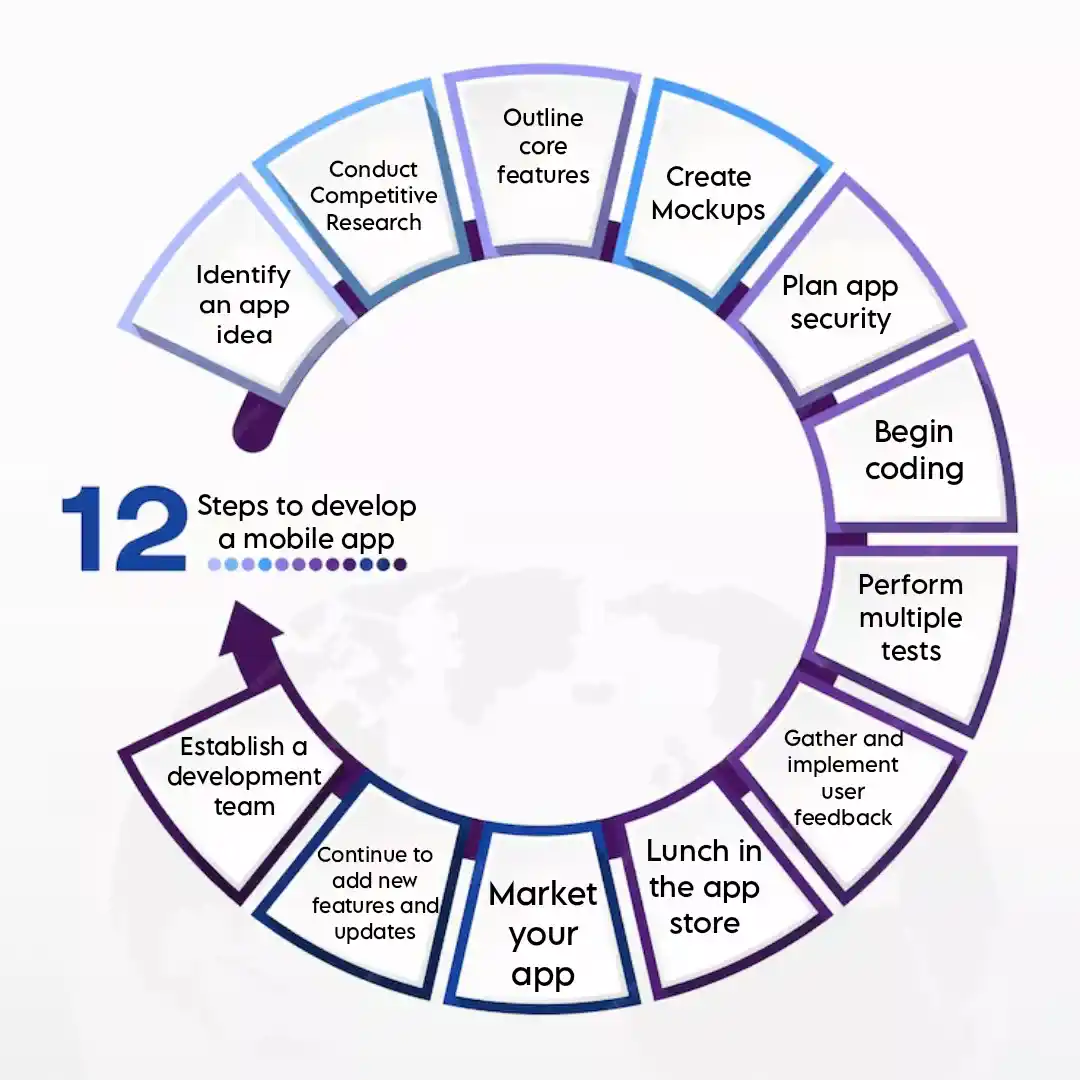Table of Contents
Until recently, businesses often resort to develop a mobile app due to tight budgets and lengthy timelines. However, with the proliferation of user-friendly development platforms and intuitive software tools, many small businesses are now taking the reins and developing mobile apps in-house.
As a consequence, an increasing number of companies are recognizing the transformative potential to develop a mobile app, whether for internal processes or customer engagement. Despite the initial apprehension that comes with embarking on app development, the journey proves to be immensely rewarding.
This comprehensive guide is designed to walk through the intricacies of the app development lifecycle, empowering one to harness the power of mobile technology. From conceptualization to deployment, each step is meticulously outlined to ensure
How to develop a mobile app in 12 steps?
To develop a mobile app is a complex process that involves numerous stages, each crucial to the app’s success. Here’s a comprehensive 12-step guide to develop a mobile app efficiently:

1. Identify an App Idea
To develop a mobile app, one should start with a compelling idea by identifying a unique problem or market gap. Consider the target audience and how the app adds value. Use surveys, focus groups, and online tools to gather insights and validate the idea. Aim for a clear, concise app concept that addresses a specific problem or enhances an existing solution. For example, churches are increasingly turning to mobile apps to engage their communities, offering features like online giving, event updates, and sermon streaming. Apps for churches are a great example of how organizations can use mobile platforms to meet the specific needs of their audience.
s
2. Conduct Competitive Research
To develop a mobile app, one should begin with a solid idea, conduct competitor research, and analyze similar apps. This analysis helps understand strengths and weaknesses, identify differentiation opportunities, and avoid replication. Examining features, user reviews, and ratings reveals market trends and user expectations, guiding the app’s unique functionality and design.
3. Outline Core Features
To develop a mobile app, the team should outline core features based on market needs and competition, prioritizing essential functionalities. They should focus on creating a Minimum Viable Product (MVP) with these core features to launch quickly and gather initial user feedback. This feedback will guide further development and improvements.
4. Create Mockups
Mockups are visual representations of a mobile app’s interface, showing how it will look and function. Using tools like Sketch, Figma, or Adobe XD, developers create detailed mockups for each screen and feature. This helps visualize the user journey and identify design issues early, ensuring developers and designers are aligned on the app’s layout and user experience.
5. Plan App Security
Security is pivotal in mobile app development. It involves planning data protection and app security, like encryption, user authentication, and audits. Compliance with GDPR or CCPA should be ensured for sensitive data. Addressing security early prevents breaches and fosters user trust.
6. Begin Coding
With a solid plan and mockups, the team starts coding. Choosing the right technology stack based on requirements and target platform (iOS, Android, or both) is crucial. Utilizing development frameworks and tools, whether native (Swift for iOS, Kotlin for Android) or cross-platform (React Native, Flutter), is necessary. Breaking down the development process into manageable tasks and following agile methodologies ensures iterative progress and timely feedback.
7. Perform Multiple Tests
Testing is vital in mobile app development for functionality, usability, and performance assurance. Various tests like unit, integration, and system testing are crucial. Automated tools expedite testing, while manual checks catch nuanced issues. Beta testing with select users offers real-world insights. Comprehensive testing detects and rectifies bugs pre-launch, ensuring a smoother app release.
8. Gather and Implement User Feedback
Post-testing, and gathering feedback from users who interacted is vital in developing a mobile app. Surveys, reviews, and direct feedback help understand their experience, and identify improvement areas. Analyzing this feedback refines features, fixes issues. Implementing changes enhances user experience, and meets expectations.
9. Launch in the App Store
After testing and refining the app, the next step is preparing for its launch on the app store. Creating compelling listings with detailed descriptions, high-quality screenshots, and videos is essential. Following the guidelines of platforms like Google Play Store and Apple App Store ensures a smooth submission. Optimizing listings for relevant keywords enhances visibility and discoverability.
10. Market Your App
Effectively marketing the app post-launch is crucial for success. Developing a strategy encompassing social media promotion, influencer partnerships, content marketing, and paid advertising is essential. Utilizing app store optimization (ASO) techniques boosts the app’s search ranking. Engaging with potential users across channels and encouraging downloads and shares fosters user growth.
11. Continue to Push New Features and Updates
Continuously pushing new features and updates is essential to keep the mobile app relevant and engaging. Monitoring user behavior and feedback helps identify appreciated functionalities. Regular updates fix bugs and enhance performance, adding value to the app. Keeping users informed via in-app notifications and store descriptions maintains engagement and satisfaction.

12. Establish a Development Team
Establishing a dedicated development team is vital for sustained support and enhancements. Building a diverse team encompassing developers, designers, testers, and marketers ensures efficient handling of all app development aspects. Fostering collaboration and ongoing learning within the team aids in staying abreast of technological advancements and market shifts.
By following these 12 steps, anyone can develop a mobile app that is well-planned, user-friendly, and successful in the competitive app market. Each step is vital in ensuring that the app not only meets user expectations but also stands out in a crowded marketplace.
Related Article:
Custom Mobile App Development: Empower Business by 2X Growth
Summing Up: Insights into App Development
Following these 12 steps can streamline the successful development of a mobile app. Each stage is crucial in ensuring the app’s viability and user satisfaction from ideation to launch and beyond. By identifying an innovative idea, conducting thorough research, and assembling a skilled team, developers can confidently navigate the complexities of app development. With diligent planning, testing, and continuous improvement, creating a standout mobile app becomes an achievable goal.